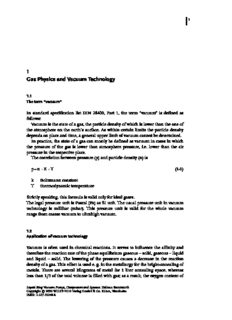
Gas Physics and Vacuum Technology PDF
Preview Gas Physics and Vacuum Technology
1 1 Gas Physics and Vacuum Technology 1.1 Theterm“vacuum” In standard specification list DIN 28400, Part 1, the term “vacuum” is defined as follows: Vacuumisthestateofagas,theparticledensityofwhichislowerthantheoneof the atmosphere on the earth’s surface. As within certain limits the particle density dependsonplaceandtime,ageneralupperlimitofvacuumcannotbedetermined. Inpractice,thestateofagascanmostlybedefinedasvacuumincasesinwhich the pressure of the gas is lower than atmosphere pressure, i.e. lower than the air pressureintherespectiveplace. Thecorrelationbetweenpressure(p)andparticledensity(n)is p=n·K·T (1-1) k Boltzmannconstant T thermodynamictemperature Strictlyspeaking,thisformulaisvalidonlyforidealgases. ThelegalpressureunitisPascal(Pa)asSIunit.Theusualpressureunitinvacuum technology is millibar (mbar). This pressure unit is valid for the whole vacuum rangefromcoarsevacuumtoultrahighvacuum. 1.2 Applicationofvacuumtechnology Vacuum is often used in chemical reactions. It serves to influence the affinity and thereforethereactionrateofthephaseequilibriumgaseous–solid,gaseous–liquid and liquid – solid. The lowering of the pressure causes a decrease in the reaction densityofagas.Thiseffectisusede.g.inthemetallurgyforthebright-annealingof metals. There are several kilograms of metal for 1 liter annealing space, whereas lessthan1/3ofthetotalvolumeisfilledwithgas;asaresult,theoxygencontentof LiquidRingVacuumPumps,CompressorsandSystems.HelmutBannwarth Copyright:2005WILEY-VCHVerlagGmbH&Co.KGaA,Weinheim ISBN:3-527-31249-8 2 1 GasPhysicsandVacuumTechnology theresidualairislessthan1mginthepressurerangeof10mbar.Comparedtothe metalmass,theoxygencontentdecreasesto10–5.Thisleadstoaretardationofthe oxidation process, thus allowing higher process temperatures. It also causes an increase in the ductility of the products. When teeming melted materials, such as metals, apart from a retarded oxidation also degassing (desorption) takes place at the same time. The result is metal of particular purity. In the metal and sinter ce- ramics industry, sintering processes are based on the same principle. The impedi- ment of fermentation caused by aerobe micro-organisms with the help of vacuum can also be called reactive retardation, an example of which is vacuum packaging. Ontheotherhand,areactiveaccelerationisreached,e.g.whenaftertheevacuation ofthematerialstobetreated,gasesorliquidsaredischargedinordertoincreasethe reactiondensity.Thereactiondensitycanalsobecontrolledasrequiredbymeansof a decrease in pressure, e.g. when chlorinating. In this case, diluting gases are not required. Theselectionoftheadequatetechnologyforachemical-physicalprocessdepends onpressure-relatedparametersandthespecificcharacteristicsofthematerialtobe treated.Thisrequirese.g. . thedeterminationoftheoptimalrangesofvacuumandtemperature, . thedeterminationoftherequiredequipment, . thedeterminationofallnecessaryauxiliarymeans,whichvacuumpumpsor vacuumdevicesbelongto. The dimensions of a vacuum plant are not only determined by the performance data of the process devices, but also by the operating range of the vacuum. In the rangeofhighvacuumthesizesoftheindividualdevicesarenotasimportantforthe dimensionsofthetotalplantastherequiredsuctioncapacity andthesizesanddi- mensionsofthevacuumpumps,i.e.thevacuumpumpstations. Generally, in vacuum process engineering of the chemical industry or related branchesvacuumplantsusuallyconsistofthefollowingmaincomponents: . Vacuumdevicesfortheexecutionoftheprocess . Condensationdevicesforthecompressionofthearisingvapor . vacuumpumporcombinationofpumps . accessories, such as separators, heat exchangers, vacuum vessels, metering andcontroldevices. 1.2.1 Basicoperationsinprocessengineering In the industrial process engineering, basic operations are usually carried out in coarsevacuum,seldominfinevacuum.Theapplicationof highvacuumisconsid- eredonlyinparticularcases. The machines used here are vacuum pumps and compressors. With lower vacuumsandhigherflowratesmostlyextractorfansareused. 1.2 Applicationofvacuumtechnology 3 Regarding the use of waste heat and the careful heating of thermally sensitive materialitisadvantageousfortheperformingofthevacuumprocesstoworkatlow temperatures.Themostdifferentprocessesarecarriedoutthroughvaporizing,dry- ing, condensing, degassing, filtering etc. under vacuum. Generally, it can be said thatthetotaloperatingcostsofvacuumplantsincreasewithhighervacuum. Mechanical vacuum pumps can be designed as dry or wet running pumps with pistonsorrotatingelements. Dry running vacuum pumps are used for pumping dry and non-condensable gases.Incaseofexistingcondensablevapors,condensershavetobeinstalledonthe suction side in which the condensable particles are condensed through cooling. In the field of coarse vacuum, usually surface condensers or mixing condensers are used, while low-temperature condensers or absorption condensers are used in the finevacuumrange. Wetrunningvacuumpumpsareparticularlysuitableforthesuctionofcondensa- blevaporsorgases,aswellasformixturesofgasesandliquids.Inwetrunningvac- uum pumps driven by an operating liquid (e.g. water or another liquid chosen accordingtotheprocess),theprocessgascanbecondensed.Owingtothisfact,con- densersinstalledonthesuctionsideofthepumpsarenotrequired.Thediagramof thebasiclayoutofavacuumdeviceisshowninfig.1-1. Figure1-1. Basicschemeofavacuumplant 1 vacuumvessel 2 condenser 3 liquidringvacuumpump 4 liquidseparator 1.2.2 Basicfieldsandworked-outexamplesfortheapplicationofvacuumtechnology Vacuumtechnologyisdominantinmanyfieldsofresearchandindustry(Table1-1) andisappliedbyusingthemostdifferentprocesstechnologies(Table1-2). 4 1 GasPhysicsandVacuumTechnology Table1-1. Fieldsofapplicationofvacuumtechnology[1.1] Fieldofknowledge Branchofindustry/technology Physics(mechanics,continuum Scientificinstrumentproduction(precisionmechanics) mechanics,thermodynamics, Mechanicalengineeringandheavyengineeringindustry electrodynamics,optics,nuclear Electronics(formeasuringandcontrolproblems) physics,surfacephysics-and Automationandcontrolling chemistry) Cryogenicengineering Biophysics Chemicalprocessengineering(oils,greases,waxes,resins etc.) Physicalchemistry Metallurgy Chemistry Materialengineering State-of-the-arttechnologies(glass,ceramicsandmetallic compounds) Pharmacy Medicine Fieldofapplication Examples Nucleartechnology Crystalgrowing(scintillationdetectors) Evaporation(solid-statedetectors) Workingwithclosedsystems(hotlaboratories,plutonium, etc.) Filtration Sinteringundervacuum(nuclearmetals,ceramics,carbide) Opticalindustry Vaporizationtechnologies(interferencelayers,laser,maser, glassfiberoptics,optoelectronics) Electricalengineering/electronics Drying(insulationoils,coolants) Impregnation(insulationmaterial) Hermeticsealing(boosters) Evacuationanddegassing(e.g.tubes,lamps) Evaporationandsputtering(e.g.condenserproduction,thin- filmtechnology) Encapsulation(tubes,semiconductorelements) Weldingandsurfacetreatment(micro-circuits) Crystalgrowing(epitaxialgrowth) Surfacereactions(transistors,circuits) Scientificinstrumentproduction Physicalandchemicalanalyses Analyzingappliances(surfaceanalysis,UVexamination, electronandionmicroscopes,X-rayanalyzers,microwave devices) Lowesttemperatureanalyses Particleaccelerators,storagerings Fusionplants Chemicalindustry Distillation(fattyacids,oils,alcohol,etc.) Filtration Drying,dehydration vaporization,sublimation 1.2 Applicationofvacuumtechnology 5 Fieldofapplication Examples Foodindustry Freeze-drying(freshandcookedfood) Preservationandconservation Dehydrationandconcentration(milk,coffee...) Crystallization(e.g.sugar) Pharmaceuticalindustry Distillation(vitaminA,E,...) Freeze-drying(blood,...) Drying(antibiotics,hormones,...) Sterilization(dressingmaterials,...) Metallurgyandsemiconductor Distillation(Mg,Ca,Li,Se,Na,K,...) manufacturing Reduction(Ti,Mg,Zr,Fe,Cr,...) Sintering(high-meltingandreactivemetals,carbides,...) Meltingandcasting(Pb,Sn,Mn,Ge,alloys,high-melting andreactivemetals) Drying(powder) Heattreatment Productionengineering Impregnation(moldsforcasting) Injectionmolding(Mgalloycomponentswithoutvoids) Fastening(chucks) Weldingandsoldering(precisiondevices) Surfacefinish(hardmaterialoranticorrosioncoating) Spaceengineering Biologicalprocessesanddevelopments Materialdevelopmentandcontrol Developmentandcontrolofdevices(motors,gauges,...) Officemachinesindustry Weldingandtreatment Registration Heatinsulation Transportationinvarious Liftingandtransporting(paper,metalsheets,pavement industrybranches plates,cathoderaytubes,...) Miscellaneousapplications Evaporation(paper,plastics,fabrics,...) Thermalinsulation(Dewarflasks,...) Forming(plastics,vacuumcasting) Concretehardening 6 1 GasPhysicsandVacuumTechnology 1.2.3 Overviewofthemostimportantvacuumprocesses Tab.1-2containsprocessespreferablycarriedoutundervacuum. Table1-2. Vacuumprocessesinprocessengineering[1.2] Process Importantadvantagesthroughvacuum Endothermicprocesses Vacuumvaporization Lowtemperatureofmaterialandheatingagent Increasedheatefficiency Vacuumdistillation Betterseparationeffect,moleculardistillation; Oxide-freeandgas-freemetaldistillation Vacuumsublimation Undertriplepoint(freeze-drying) Vacuumdrying Quickandcarefuldryingwithoutshrinking; increaseddissolvingspeed Vacuumcalcination Shiftingofphaseequilibrium,decomposingtemperaturedrops Vacuumannealingand Brightannealedproductsarefreefromoxides,gasesandscale sintering Vacuummelting Gas-freemeltedproduct,high-puritymetals,chemicals,plastics, sealingcompounds Vacuumcasting Non-porouscastproductswithhighdensity Vacuumsoldering Furnacesolderingwithoutflux,oxide-freehardsoldering Vacuumevaporation Surfacefinishthroughvapordepositionofthinfilmsofmetals andnon-metals Vacuumreaction Thermalconversionatlowtemperaturesanddecreasedreaction density Vacuumsteamgeneration Watervaporheatingbelow100MC,rapidcontrol Processeswithoutcatalyticoxidation Vacuumdegassing Gas-freeliquid,viscose,plasticmasses Vacuumgasinjection Fumigation,disinfection,sterilisation,sorption Vacuummixing Modifiedsorption,improvedwettability Vacuumextraction Higherdissolverspeed,dissolverrecovery Vacuumfiltration Continuousresiduedecreasing Vacuumimpregnation Completeimpregnationofporousbodies,agglutination Vacuumtransport Fluidizedbedtransportofbulkmaterialsbymeansofinduced draught Vacuuminsulation Thermo-barochamber Vacuumpackaging Improvedshelflife,noaromalosses Exothermicprocesses Vacuumcondensation Distillaterecovery,higherenergyyield Vacuumcooling Icegenerationwithoutcoolants Vacuumcrystallization Highercrystalyieldthroughflashdistillationofsolvents Vacuumreaction Higherdistributionrate,lowreactiondensity Vacuumpresses Non-porousagglomerationoragglutinationofpowdersand laminates 1.2 Applicationofvacuumtechnology 7 1.2.4 Basicdesignsofapparatusformasstransferandmasscombination Themostimportantvacuumprocessesapplied inprocessengineeringaregivenin Table1-3.Theyaresubdividedaccordingtothermalprocessesandgroupedtogether accordingtotheapparatusequipment. Table1-3. Basicsymbols,apparatusandprocesstechniqueinvacuumengineering[1.2] 8 1 GasPhysicsandVacuumTechnology 1.2.5 Limitstotheapplicationofvacuuminprocessengineering In the field of vacuum, the kind of gas flow depends on the respective prevailing vacuum. AccordingtotheHagen-Poisseuillelaw,laminargasflowexistsincoarsevacuum. Intherangeofhighvacuum,theinternalfrictionisnolongerdecisive,asthecolli- sionofthemoleculesandthetubewalloccursmoreoftenthanthecollisionamong the molecules themselves. This kind of flow is called Knudsen molecular flow, i.e. theaveragemolecularspeedandthemeanparticlepathofthegasmoleculesdeter- mine the flow process. The range between coarse and high vacuum is called fine vacuum. The fine vacuum range is the transition zone between the Hagen-Pois- seuilleflowandtheKnudsenflow.Therangeofvacuumshigherthaninhighvacu- umiscalledultrahighvacuum. AccordingtotheKnudsonequation l K¼ d (1-2) thedifferenttypesofflowaresubdividedasshownintable1-4. Table1-4. Flowtypesinvacuum[1.3] K <0.5 0.5–3.0 >3.0 Typeofflow Hagen-Poiseuilleflow Transitionzone Knudsenmolecularflow K Knudsennumber l meanfreepath[m] d diameteroftheflowchannel[m] Therefore,forthetypeofflowarisingintubes,theratioofthemeanfreepath(a gas molecule does on average until its collision with another molecule), which increaseswithdecreasingpressureandthediameteroftheflowchannelisdecisive. Materialtransport.Withtheincreasingvacuum,thetransportofgasesandvapors gets more and more difficult. This is a result of the fact that with decreasing pres- surestheavailableforcesdiminishandthevolumesincrease.Withpressureslower than0.1kPa(=1.0mbar),inpracticeonlyinsignificantquantitiesofgasandvapor aretransportedinpipes. Heat transport. Only in the range of atmospheric pressure heat transfer through convectionistechnically applicable,whereas highvacuumisagoodheatinsulator. Invacuumprocesses,theheating-upofthematerialoccurspracticallyonlyindirect contact with heating elements through radiation, rarely through dielectric heating orinductiveheating. 1.3 Operatingrangesandmeasuringrangesofvacuum 9 1.3 Operatingrangesandmeasuringrangesofvacuum Vacuumrangesarerangesofpressuresorparticledensitiesaccordingtowhichitis agreedtoclassifyvacuum. Theroundeddownlimitsoftheserangesarelistedaspressurevaluesorequiva- lentparticledensityvaluesinTab.1-5. Theparticledensityvaluesgiveninthetableapplytoatemperatureofd=20MC. 1.3.1 Vacuumpressureranges Table1-5. Vacuumranges(acc.toDIN28400,Part1,July1979) Formula Unit Coarsevacuum, Finevacuum, Highvacuum, Ultrahighvacuum, character CV FV HV UHV P [Pa] 1·1015to1·102 1·102to1·10–1 1·10–1to1·10–5 <1·10–5 P [mbar] 1·103to1 1to1·10–3 1·10–3to1·10–7 <1·10–7 n [m–3] 2.5·1025to 2.5·1022to 2.5·1019to <2.5·1015 2.5·1022 2.5·1019 2.5·1015 It seems to suggest itself to divide measuring ranges in decimal powers, as fol- lows: Millibarrange from1000to1mbar,essentiallythenormalandcoarsevacuum range Microbarrange from1to10–3mbar,thefinevacuumrange Nanobarrange thehighvacuumrange Picobarrange andbelow,theultrahighvacuumrange 1.3.2 Vaporpressurecurveofwaterinvacuum Forvacuumprocessengineeringwithaprevailingthermalmasstransfer,itisprac- ticalandclearertodivideintovacuumoperatingrangesfollowingthethermometric fixedpointsofwaterasso-calledfundamentalmaterialwhichthechemists,process engineersandtechnicianshavetodealwitheveryday(Fig1-2).Accordingtothis,in theboilingrangeofpurewaterbetween0and100MCcorrespondingto6.11mbarto 1013mbar, the normal orbasic vacuum range results, inwhich the boiling process alwaysoccursaspurevaporization. Processes with lower pressures at which vaporization takes place through subli- mation from the solid phase (ice) below 0MCare to be allocated to the fine or high vacuumrange. 10 1 GasPhysicsandVacuumTechnology Figure1-2. Vaporpressurecurveofwaterindifferentvacuumranges[1.2] 1.3.3 Vacuumoperationranges,temperaturepressuretable InTab.1-6,vacuumoperatingandmeasuringrangesinmillibarandTorrarecom- pared to the specific boiling points of pure water (H O), mercury (Hg), methanol 2 (CH OH)andethylalcohol(C H OH).Fromthis,thedifferencebetweenthevapor 3 2 5 pressuresoftheindividualfluidsandthedependenceonthepressuretemperature are clearly deriving. In fine and high vacuum, the operating ranges coincide with themeasuringranges.
Description: